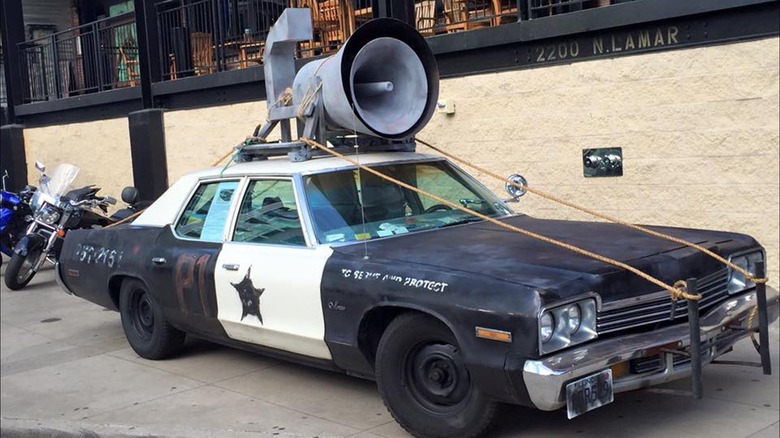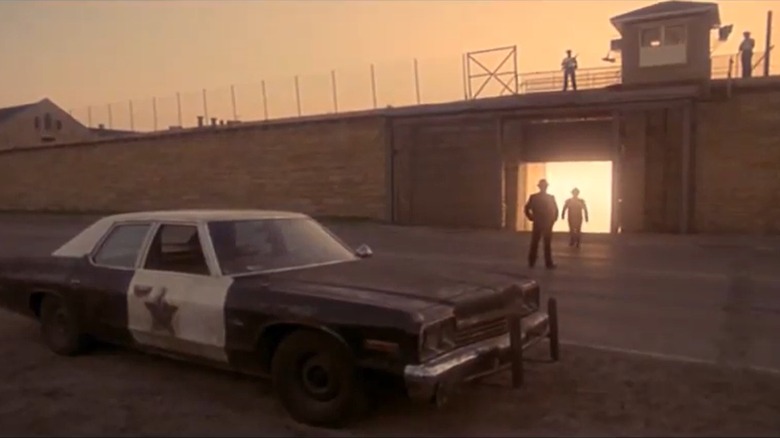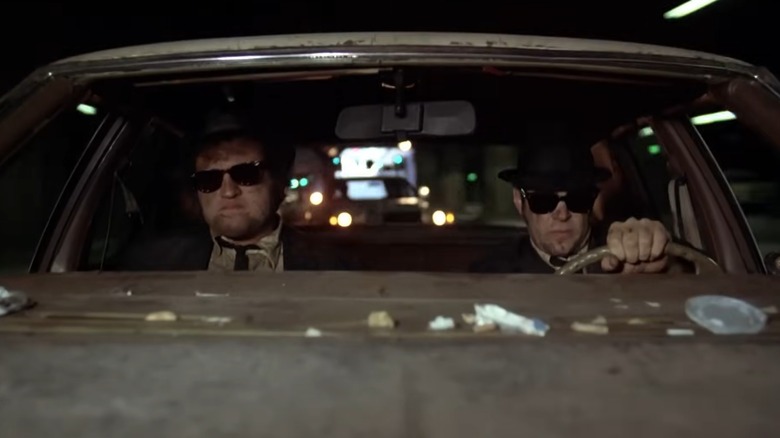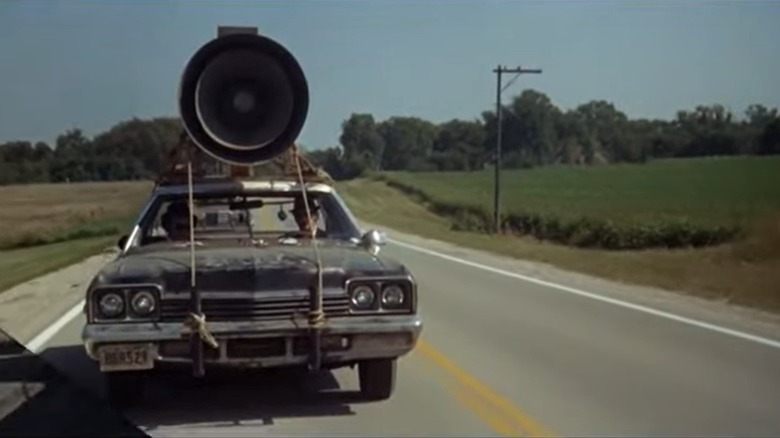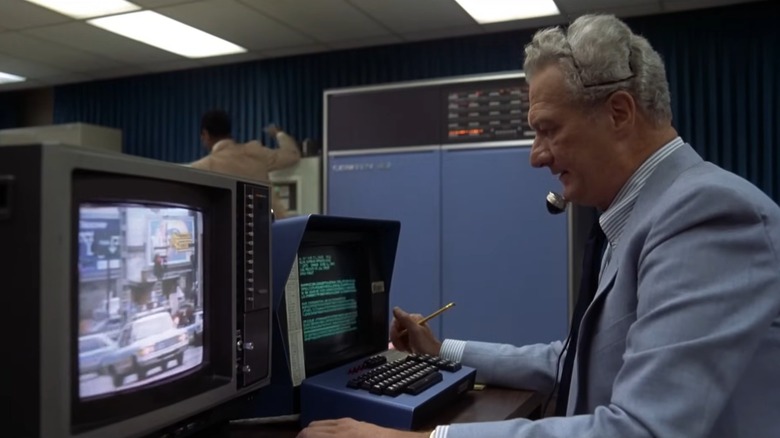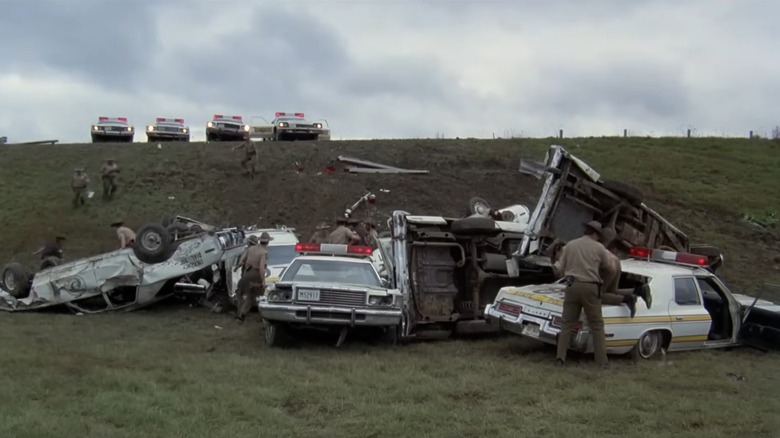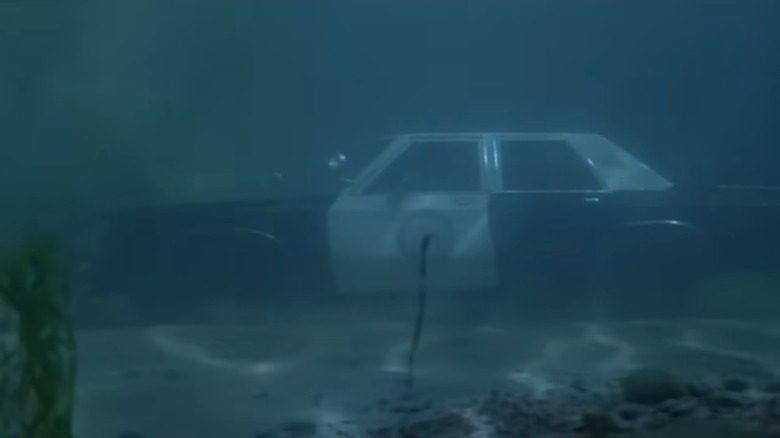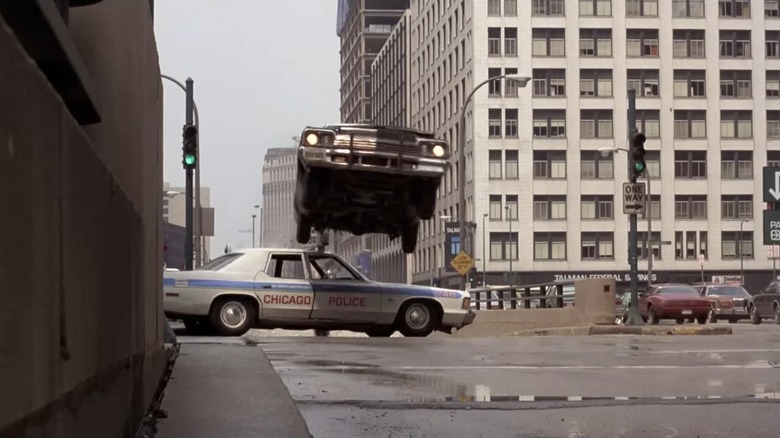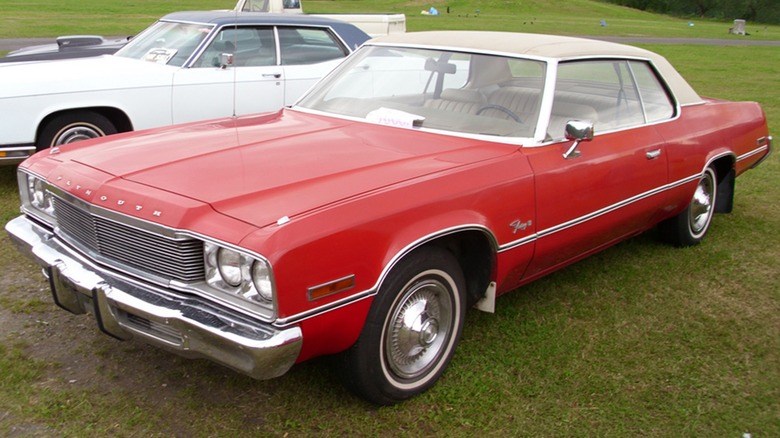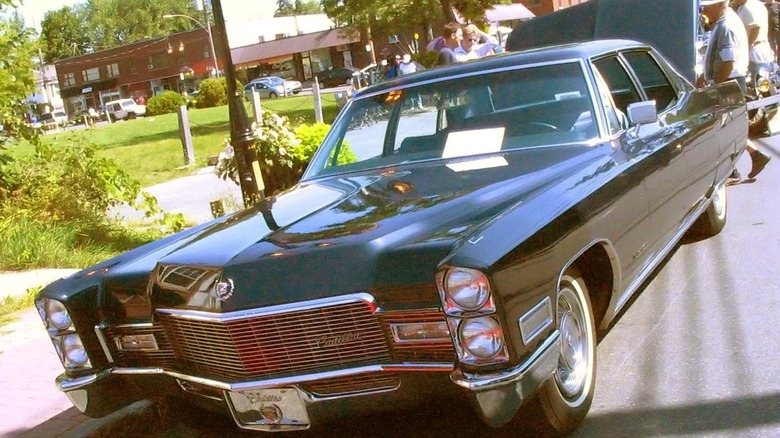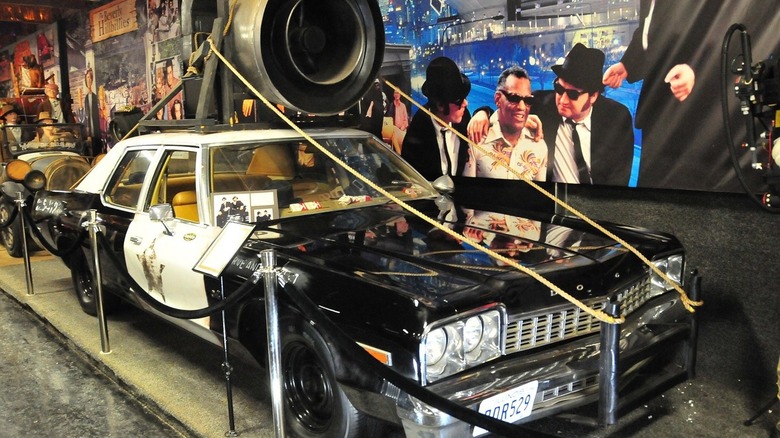10 Facts About The Blues Brothers' Iconic 1974 Dodge Monaco 'Bluesmobile'
Everyone has their favorite car chase movie. Many gravitate towards the "Mad Max" films because of their Frankenstein vehicles (all of which were built practically with real car parts) and wasteland chic style. Others, meanwhile, favor the "Fast and the Furious" series thanks to its flashy cars that would be the diamond of any collection. There's also the pinnacle of 1980s car chase movies, "The Blues Brothers."
In case you have never heard of it, the film stars Dan Aykroyd and the late John Belushi as the titular Blues brothers Elwood and "Joliet" Jake, respectively. The two are on a mission to reunite their band and raise enough money to save the orphanage they grew up in, and nothing is going to get in their way; not the Nazis, not the cops, and certainly not their rap sheets. While the Blues brothers are the story's deuteragonists, the true star of the film is the iconic Bluesmobile, a 1974 Dodge Monaco police car that Elwood bought at an auction.
Not only does the Bluesmobile get the Blues brothers where they need to go, but it also manages to outrun every roller in Chicago and pull off stunts that would total fewer vehicles. How does it do this? In the movie, it's because the Blues brothers are on a mission from God, but behind the scenes, it's because of movie magic.
Here are 10 facts you might not have known about the Bluesmobile.
[Featured image by DowntownMe via Wikimedia Commons | Cropped and scaled | CC BY-SA 4.0]
13 Different Cars Were Used to Depict the Bluesmobile
When filmmakers have to build a vehicle for a sci-fi movie or show, they usually start with an existing car or motorcycle and customize it until it's unrecognizable. However, just because a movie such as "The Blues Brothers" takes place in a contemporary world almost identical to our own, doesn't mean the filmmakers used stock cars for their shoots.
The "Bluesmobile" was actually a fleet of 13 different 1974 Dodge Monacos that the filmmakers swapped out depending on what they needed to do. Some were used for stunts, while others were reserved for high-speed chase scenes. Forty stunt drivers got behind the wheels of these specialized vehicles, while John Belushi and Dan Aykroyd only got to sit in five of them. One of the most expensive customizations consisted of a Monaco that was rigged to fall to pieces with the flip of a switch. Mechanics worked on that particular car for several months, and it was only used for one scene, but their efforts created one of the movie's more memorable and heart-wrenching moments.
While the Bluesmobile is an iconic vehicle, it needed other cars to pursue it. Otherwise, there would have been no car chases. To that end, the filmmakers purchased 60 used police cars at $400 a pop – that's about $1,600 per car, adjusted for inflation.
The Car Actually Could Go 118 MPH
The dark secret of most films is that they are one big illusion. If you see someone running atop a speeding bullet train, that scene was probably the result of a green screen, wires, and a giant fan. However, when impressive car stunts are involved, what you see on the big screen is often what actually happened.
During the jam-packed chase scene through Chicago in "The Blues Brothers," you can see the Bluesmobile's speedometer cranked up to 118 mph. On the surface, it's an effective use of "show, don't tell" to demonstrate how fast the Bluesmobile was going. However, that wasn't just the result of movie magic; one of the 1974 Monacos used in the film actually could go that fast.
When shooting the Chicago car chase, director John Landis was afraid audiences would assume he just sped up the film to make it look like the Bluesmobile was breaking 100 mph. As a result, he reshot the scene, complete with stunt actor pedestrians, to prove that the number on the speedometer was no idle boast. However, that insistence came at the risk of the Bluesmobile or cop cars running into a non-stunt car or real pedestrian.
To avoid such potentially fatal accidents, the film crew shot these scenes during early Saturday and Sunday mornings. Plus, they worked with real police officers to tie off blocks of city streets. Landis even had his own "war room" with a city map so he knew precisely where the Bluesmobile would be and where pedestrians couldn't.
Many Customizations Were Aykroyd's Idea
Before "The Blues Brothers" was a movie, it was a recurring musical sketch on "Saturday Night Live" — and yes, Dan Aykroyd and John Belushi played the characters in these bits, too. When it came time to bring the brothers to the big screen, Dan Aykroyd penned the script and the lore, including why the car looked the way it did.
Let's start with the obvious: Why did Aykroyd want the Bluesmobile to be a 1974 Dodge Monaco? When Aykroyd wrote the script, the Monaco was one of the hottest and most popular cop cars around (and it still is). While professional prop and vehicle artists added scrapes and dents to the car, Aykroyd added little character touches such as the junk on the dashboard — e.g., used cigarettes, matches, and gum wrappers.
Aykroyd's fingerprints can also be found all over the giant loudspeaker the Blues brothers use to spread word about their comeback performance. When audience members watch that scene, many probably wonder what the heck they're looking at. The answer is a replica of a Cold War-era air raid siren, because Aykroyd requested the Bluesmobile loudspeaker look like the one from his elementary school, Our Lady of Annunciation, in Hull, Quebec. We also can't forget that Aykroyd also essentially designed the Bluesmobile's license plate. "BDR 529" might sound like standard license plate gibberish, but the first three letters actually stand for "Black Diamond Riders," a biker gang from Toronto that Aykroyd liked.
Nobody Ever Called The Bluesmobile a 1974 Dodge Monaco
Every famous vehicle in fiction has two names: its model and its nickname. For instance, the original K.I.T.T. from "Knight Rider" (which has spent its retirement years in museums and private collections) is also known as a modified 1982 Pontiac Firebird Trans Am.
If you pay attention in the film, nobody ever calls the Bluesmobile a 1974 Dodge Monaco, not even people whose job it is to properly identify car models. When the cops who initially pull over the Blues brothers give chase and call it in, they identify the vehicle as a "black and white 1974 Dodge sedan." On one hand, that's exactly what the car is, but on the other hand, Dodge sold more sedans in 1974 than just Monacos — e.g., the 1974 Charger, so it's not exactly the best description to provide when requesting help on a high-speed pursuit. The next time the cops see the Bluesmobile, they call it "that s—box Dodge." Again, they don't call it a Monaco, but at least this time they're not broadcasting that personal label over the radio.
Despite never actually being identified as a 1974 Dodge Monaco, audiences eventually found out the truth. Depending on which "original" script you find floating around the internet, you might read a copy that name drops the car's model. Assuming the validity of the script, one might wonder why it was changed in the first place.
Filmmakers Required a 24-Hour Body Shop
Every car needs maintenance. Shocking, but it's true. The mere act of using an automobile stresses its parts, and you need to take it into a shop sooner or later. Depending on the abuse a car experiences, like, say, participating in a ton of car chases and demolition derby sequences, it will definitely need a visit "sooner."
Despite having a veritable surplus of squad cars (and Bluesmobiles), the filmmakers still wrecked so many cars that they needed help maintaining enough vehicles for a shoot. They utilized a 24-hour body shop in the Near West Side to fix demolished cars to keep the show running. How else could the studio have smashed up approximately 100 vehicles in the film despite not purchasing that many?
While the cop cars received the majority of these repairs since they got flung every which way during chase scenes, it stands to reason that the Bluesmobiles also received some of those fixes as well. Of course, the filmmakers only needed to maintain their fleet so long as the film kept running. Once production stopped, they didn't need to fix any more cars, so any vehicles that were wrecked by the wrap-up stayed wrecked, including police vehicles and Bluesmobiles. This 24-hour body shop might have also been where engineers rigged the 1974 Dodge Monaco designed to fall apart, but given all the cars they had to repair, it's a miracle they had enough time to finish that project.
Dan Aykroyd's Scrapped Ideas
It's an open secret that not every concept for a movie makes it into the final product. Sometimes, these ideas are scrapped early on because they don't work; other times, they're filmed but later removed for the sake of runtime. "The Blues Brothers" was no different.
One of the most famous scrapped scenes in "The Blues Brothers" explained how the Bluesmobile was able to pull off so many stunts and put up with just as much abuse. In the original script, Dan Aykroyd wrote that the Blues brothers parked their vehicle in a secret underground bunker, and it absorbed energy from transformers inside the shelter. The film crew shot the scene of the Bluesmobile receiving the electrical transfusion, but that sequence was removed in post because the movie ran too long. This decision led to the unspoken explanation that the Bluesmobile was a magic car and that Elwood Blues was an ace driver.
While the 1998 sequel, "Blues Brothers 2000," isn't regarded as favorably as the original, it also had cut scenes. For instance, Aykroyd wanted a sequence where the new Bluesmobile (which isn't a 1974 Dodge Monaco, but we won't hold that against him), went underwater and sprouted submarine propellers. John Landis returned to direct the film, and insisted they retain the "it's a magic car" explanation, overruling Aykroyd's original idea. He still filmed the car going underwater and magically functioning while submerged, but that was the extent of it.
All Stunts Were Filmed Live
Many car stunts are performed with a car, a stunt driver, and the occasional bundle of pyrotechnics. However, there's no guarantee a director will get the effect they want. Sometimes, the stunt crew needs a little extra incentive.
One of the coolest stunts in "The Blues Brothers," albeit also the shortest, involved the Bluesmobile jumping over a police car and taking out its roof lights. When director John Landis proposed this idea to the stunt driver at the time, he was given a bit of bad news. Apparently, the driver could only guarantee that he could "clear the cop car," not graze it. However, Dan Aykroyd and John Belushi offered the stunt person $1,000 each if they could carry out Landis' vision. By the end of that shoot, the stunt driver was $2,000 richer, and Landis got to film his favorite stunt in the movie.
While the movie's filmmakers usually insisted on realism, sometimes they tried to cut corners. For one stunt, the Bluesmobile was supposed to "tumble end over end" through the air. The stunt crew thought it would be best to create a miniature Bluesmobile (which was over four feet long) and launch it. However, no matter how many ideas the effects people proposed, the end results always landed flat, so, they just gave up and decided to fling a full-size Bluesmobile into the air and film the result. That is the sequence that made it into the film.
The Bluesmobile Wasn't Originally a Monaco
Scriptwriting is an iterative process. You get all of your ideas out on paper, go over what you wrote, and then realize some things don't work, so you go over it again, polish the good parts, and replace the bad. Sometimes a good idea makes it into the script purely by accident.
It is said that Dan Aykroyd's original script referred to the Bluesmobile as a 1974 Plymouth, but later in the script, it is called a 1974 Dodge Monaco. Once again, depending on what "original" script you read of Aykroyd's pitch, you might find a screenplay that backs up this claim.
Ultimately, the filmmakers went with the Dodge Monaco, but how did the change occur in the first place? Well, the "it's a magic car" explanation probably doesn't apply here. The original "script" Aykroyd handed in was a rambling, 300-plus page document that had more in common with a phone book than an actual screenplay. John Landis edited the document and cut it down to a proper script size, so it's not unreasonable to assume that mistakes were made along the way. Aykroyd admitted he had never written a screenplay before, so maybe he didn't notice the accidental change in car model. Or perhaps Landis made the mistake. Still, one can't help but wonder how the movie would have changed if the Blues brothers rode around in a 1974 Plymouth instead of a Monaco.
[Featured image by Brampton80au via Wikimedia Commons | Cropped and scaled | CC BY-SA 3.0]
The Monaco Wasn't the First or Last Bluesmobile
When Dan Aykroyd created "The Blues Brothers," he envisioned them with an existing history. The same is true for the Bluesmobile, especially because one of the titular brothers didn't initially acknowledge it as such.
In the movie, when Elwood Blues picks up his brother, "Joliet" Jake wonders what happened to the original Bluesmobile, which he refers to as just "the Cadillac" or "the Caddy." Unlike the film's 1974 Dodge Monaco, the Cadillac has a clear history with the Blues brothers that audiences never learn unless they read Blues Brothers: Private – a book that delves into the Blues brothers' backstory and was written from the perspective of the nun who raised them. According to the book, the original Bluesmobile was a 1968 Cadillac Fleetwood Sixty Special, one of Cadillac's most stylish and luxurious offerings of the year. While it was no magic car, the Blues brothers got up to all sorts of trouble in their Fleetwood Sixty Special, and it had a permanent place in their hearts — well, at least in Jake's heart, as Elwood was willing to trade it for a microphone.
While the Dodge 1974 Monaco got the Blues brothers through their first theatrical adventure, it gave up the ghost by the end of the film, so Elwood needed a new set of wheels for the sequel. Instead of buying another 1974 Monaco, he chose a 1990 Ford LTD Crown Victoria.
[Featured image by Bull-Doser via Wikimedia Commons | Cropped and scaled | Public Domain]
What Happened Afterwards?
After a film has wrapped production, props, costumes, and vehicles are either destroyed or put into storage. Even if something is stored, there's no guarantee the interior conditions will safeguard it from the ravages of time, dust, and mold. If something is either destroyed or beyond salvaging, the only way to preserve history is through replicas.
As previously stated, the crew of "The Blues Brothers" ran through so many cars they had to open up a 24-hour body shop to maintain a fleet of filmable vehicles. Once the shooting wrapped, the patrol cars and Bluesmobiles that were totaled stayed totaled. So far, nobody has found a Bluesmobile that survived, but that doesn't mean its legacy is dead. A California Highway Patrol car was repurposed into a new Bluesmobile show model that currently resides in the Volo Museum. While this particular car isn't an actual 1974 Dodge Monaco, according to some claims, it appeared in the film for certain shots.
Before the vehicle found its home, Dan Aykroyd used it to promote his line of vodka, Crystal Head Vodka. While the car is mostly identical to the Bluesmobile in the film, it received some noteworthy additions in the form of an autograph. Aykroyd's signature graces the right passenger door. Aside from surface-level changes, though, this museum-piece Bluesmobile retains most of its cop car heritage. In fact, if you opened the trunk, you could still find all the original police gear intact.
